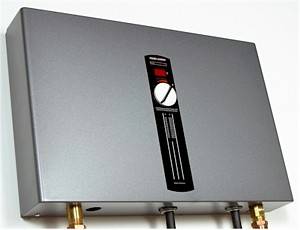- 6 reads

Twelve weeks remain on eligibility for the American Recovery and Reinvestment Act (ARRA) so if you are in the market for a new hot water system, consider going tankless and you could be eligible for a 30% tax credit.
Tankless water heaters heat water without the use of a storage tank. The same way you don’t boil water for spaghetti 10 hours before you’re ready to start cooking, you don't need to have water heating for a shower you’ll take tomorrow.
Tankless water heaters save energy by heating water as needed, are wall mounted and replace a traditional tank style water heater. The units can be either electric or gas fired and can provide 2-5 gallons of on demand hot water per minute (a typical shower head uses 1.6 gallons of water per minute).
The unit options can accommodate a variety of scenarios and are either Point-of-use heaters or Whole House units. Point-of-use tankless water heaters are small enough to fit inside a cabinet and are generally used for one fixture. These units are cheaper than the Whole House unit and provide the needed hot water. The Whole House tankless water heater is a bigger, centrally located unit that could allow for multiple fixtures to be operated at the same time.
Regardless of size unit you choose the basic technology is the same. In both cases, cold water enters the unit and is heated by either an electric resistance heating coil or a gas fired burner. Gas fired units, however, are powered by gas or propane, have more heating capacity, and a generally used for larger Whole House tankless units.
When deciding the size of your tankless water heater, the following items are crucial:
1.The volume of water the unit will need to heat for the existing fixtures, as measured by the cumulative flow rate
2.The temperature of the cold water entering the system (temperature of the groundwater)
3.The temperature of the hot water exiting the unit.
Many tankless water heaters are rated on their temperature rise. For instance, if you want the temperature of your shower to be 110 degrees Fahrenheit and the water entering the system is 72 degrees Fahrenheit then you would need at 38 degree temperature rise unit. However, the slower the water moves through the unit, the more it can be heated. Therefore, a system capable of a 33 degree Fahrenheit temperature rise at 2.0 gallons per minute (GPM) would also be capable of a 65 degree Fahrenheit temperature rise at 1.0 GPM.
Point-of-use units can range from $200-$600 and Whole House units can range from $1500-$2000 but both are eligible for a tax credit if installed before December 31st, 2010. So if your current water heater is more than 10 years old and in need of replacement, consider the tankless alternative to save energy and get some space back in your household.
If your system is not ready for an upgrade, you can still save money and energy by double checking all of your faucets and shower heads to make sure that they are up to date and operating under 2.2 GPM. You could also lower the temperature on your water heater. Most come out of the factory set at 140 degrees but since the average shower temperature is 110 degrees, setting the heater down to 120 degrees will save you money on energy costs and still allow you to have a nice hot shower.
As you decide which type of water heater retrofit to pursue be sure to consult a qualified professional. For more information on what energy upgrades are eligible for tax credit be sure to check out GREENandSAVE’s Residential GREEN De-Coder.

